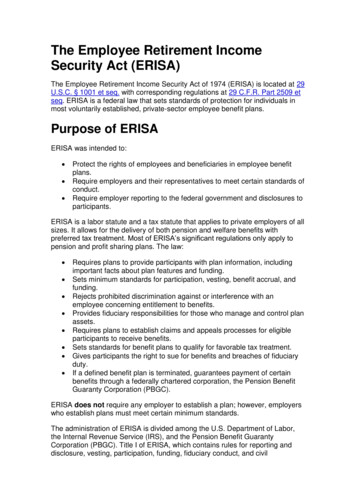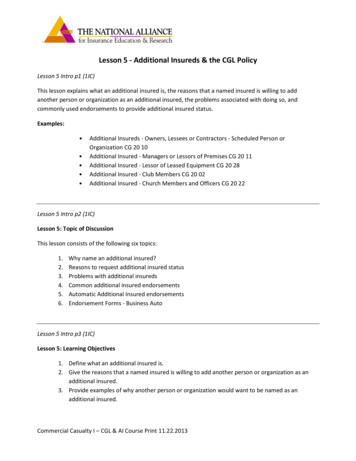
Transcription
Self-Insured Health Plansfor Beginners 2011, Coastal Management Services
Self-Insured Health Plans for Beginners Funding: Funding is simply the means by which anemployer pays for employee benefit programs The funding spectrum can range from Fully‐Insured (premium payment) to Fully Self‐Insured(employer pays all fees and claim costs) Forms of Partial Self‐Insured Plans are mostcommon 2011, Coastal Management Services
Self-Insured Health Plans for Beginners Self‐Insured vs. Fully‐Insured Fully‐Insured Plans: Premium exchanged for coverage State mandated benefits usually included Often per‐determined plan design options Limited reporting Vendors are usually controlled by the carrier Pooled Risk Self‐Insured Plans: Pay as you go coverage Customized plan design Cash flow advantage/reserves Limitless reporting Vendor management/Best in Class partners Unbundled approach 2011, Coastal Management Services
Self-Insured(Bundled and Unbundled)Insurance CarrierAdministrationUtilization Management& Disease ManagementPharmacyBenefitManagementStop Loss InsuranceNetwork AccessThird Party AdministratorAdministrationUtilization Management& Disease ManagementPharmacyBenefitManagementStop Loss Insurance 2011, Coastal Management ServicesNetwork Access
Self-Insured Health Plans for Beginners Advantages: RISK – Lower costs if claims less than expected Create a cash flow vehicle (claims funded when Flexibility of Benefit Design Portability Access to detailed claims information Ability to manage large claims & focus utilization to obtainbest contracts/pricing/outcomes Integrate best in class providers/vendors Elimination of most premium taxes Exemption from certain legislative mandates 2011, Coastal Management Services
Self-Insured Health Plans for Beginners Disadvantages RISK – Higher costs if claims greater than expected Employer pays claims expenses Fiduciary Liability is the responsibility of the employer Employer must be actively engaged in the Plan, monitoringclaim reports, vendor performance and legislative activitypreparation of employee communications (booklets, IDcards, open enrollment materials) Access to detailed claims information (HIPAA concerns) 2011, Coastal Management Services
Self-Insured Health Plans for Beginners Self‐Insured Components: A Self‐Insured Plan has 3 types of Costs (just like a Fully‐Insured Plan)Fixed (known) Costs Administration Fees (TPA, PBM, UR/UM) PPO Network Access Fees Stop Loss (Reinsurance) Premium Broker / ConsultantFunding Costs – Vary Month to Month Claims PaymentReserves (Carriers refer to “Retention”) Balance Sheet Liability for claims incurred but notreported (IBNR) 2011, Coastal Management Services
Self-Insured Health Plans for Beginners TPA Coordinates Process by Putting thePieces Together: Sets up the Plan Gives it a name (example: ABC Company Health Benefits Plan) Manages the health care budget What is its risk tolerance? The lower the premiums, the higherthe Employer’s Deductible Chooses the types of benefits to cover, such as medical,dental, prescription drugs, vision Choose its vendors (TPA/Consultant requests proposals andrecommends service vendor/partners) PPO Provider Network(s) Pharmacy Benefit Manager Utilization Review, Case & Disease Management Stop Loss Insurance Coverage Options 2011, Coastal Management Services
Self-Insured Health Plans for Beginners Terms and Definitions: Third Party Administrator (TPA). A company that provides day‐to‐day administrative services to the Plan (via the employer).Manages eligibility, customer service and claims processing. Stop Loss Carrier. An Insurance Company that provides StopLoss coverage. After an employer has met a Specific Deductible,the Carrier pays the eligible claims over the Deductible. Stop Loss. Sometimes called “Reinsurance,” “Excess Risk,”“Excess Loss.” Stop Loss in insurance purchased by an employerto protect the Plan from excessive/large claims. The employerpays Stop Loss Premiums whether or not there are any claims(homeowners / auto insurance). 2011, Coastal Management Services
Self-Insured Health Plans for Beginners Stop Loss Insurance: Who is at Risk? The Employer and Stop Loss Carrier. WithoutStop Loss, the employer assumes the risk of all eligible claims. What to Purchase? An employer can either purchase Specific(Individual) Stop Loss and/or Aggregate Stop Loss, usually both.Large employers might choose Specific only because theirclaims are considered more predictable. Credible Claims Experience. The smaller the number ofcovered employees, the less “credible” the claims experience.Claims will be less predictable. Aggregate coverage becomesmore important for smaller employer groups. 2011, Coastal Management Services
Self-Insured Health Plans for Beginners Specific and Aggregate Work Together: Specific Stop Loss: Protects the Plan against large claims on any one covered individual. The employerpays a premium for this coverage Employer chooses a Specific Stop Loss Deductible ( 50,000 per individual) based onrisk tolerance and premium affordability Aggregating Specific (Corridor): An option for a Plan that can afford to take on more financial risk in return forlower premium Employer must satisfy two levels of the specific deductible before the Specific StopLoss begins to reimburse plan (multiple member claims feed into corridor) Aggregate Stop Loss: Protects the Plan against aggregated large claims during the Plan Year (12 monthperiod) – claims that fall below the Individuals’ Specific Deductible. The employerpays a premium for this coverage The Stop Loss Carrier set the employer’s Aggregate Funding Liability at thebeginning of the Plan Year. Claims fluctuate up and down every month and shouldbe monitored by TPA. If the claims total is over the employer’s Funding Liability,the Stop Loss Carrier reimburses the employer. Typically at the end of the year, ifthe claims total is over the employer’s Funding Liability , the claims are audited bythe Stop Loss Carrier 2011, Coastal Management Services
Self-Insured Health Plans for Beginners Types of Stop Loss Contracts: Run‐In Contracts. Provides Stop Loss protection for claimsincurred before the Plan year begins but paid within thePlan Year. Run‐Out Contracts. Provides Stop Loss protection forclaims that are incurred during the Plan Year, but arereported after the Plan Year terminates. Paid Contracts. Provides Stop Loss protection for run‐inclaims (no matter when they are incurred, as long as theyare paid within the Plan Year. 12/12 Contracts (No Run‐In or Run‐Out).Least attractive, least protection, lowest price. 2011, Coastal Management Services
Self-Insured Health Plans for Beginners 2011, Coastal Management Services
Self-Insured Health Plans for Beginners How do Underwriters Price Stop Loss? Use historical data and actuarial assumptions to estimate future risk Where does the data come from? Monthly claim/enrollment reports, census, case managementreports/attending physician statements Plan Document, plan design, eligibility Human Resources Projected Claims Costs Past claims experience Plus inflationary trend Plus 25% margin for error If group is smaller, underwriter blends group experience with total block ofbusiness (manual rates) Maximum Claim Costs A 25% margin is added to the Projected Claim Costs , which is then identifiedas the employer’s Maximum Claims Funding Liability At renewal, Underwriter looks at past claims to see if employer’s claims wereover Expected, and if so, adjusts the renewal Funding Liability up to maintain a25% margin 2011, Coastal Management Services
Self-Insured Health Plans for Beginners How do Underwriters Price Stop Loss? (con’t) Lasered Specific Deductible If there is a large claimant, or an expected large claimant (i.e.,organ transplant) the Underwriter may inflate Stop Loss premiumson everyone to assume the additional risk of the claim. Or, Underwriter may keep premiums lower and apply a separate“lasered” Deductible on one individual (transfers anticipated riskto the employer)Example: Employer has a 75,000 Specific Deductible on eachcovered person. The lasered Specific Deductible is 350,000. Theemployer is only responsible for each person’s claims up to 75,000, during the policy year, except for the one individual. Theemployer is responsible for up to 350,000 on that person beforethe Stop Loss Carrier will begin to reimburse claims. Obvious premium savings, if person never experiences the largeclaim 2011, Coastal Management Services
Self-Insured Health Plans for Beginners In Summary with a Self Insured Health Plan: Customization versus “one‐size‐fits‐all’ plans Maintain control over the health plan reserves Avoid some of the conflicting state health insuranceregulations/benefit mandates under federal law (ERISA) Avoid state premium taxes, generally 2‐3% of premium dollar Employer and HR staff free to contract with best in class partners tomeet their goals 2011, Coastal Management Services
Self-Insured Health Plans for Beginners And Finally: “Self‐Insuring is far from the silver bullet to solve allhealth‐benefit cost challenges. In fact, self‐insuring aplan with really sick employees plus high dollar claimscan escalate costs and invite disaster for someemployers. What self‐insuring provides is greatertransparency that helps identify a plan’s cost drivers.That valuable information allows for intervention andtargeted cost‐management rather than a blindshotgun approach.” taken from California Broker, September 2011 2011, Coastal Management Services
2011, Coastal Management Services
Self-Insured Health Plans for Beginners In Summary with a Self Insured Health Plan: Customization versus "one‐size‐fits‐all'plans Maintain control over the health plan reserves Avoid some of the conflicting state health insurance regulations/benefit mandates under federal law (ERISA)










